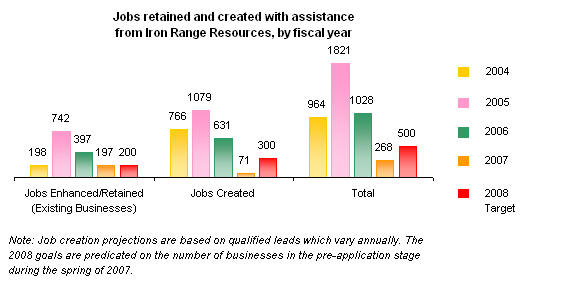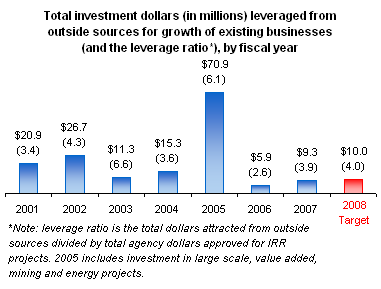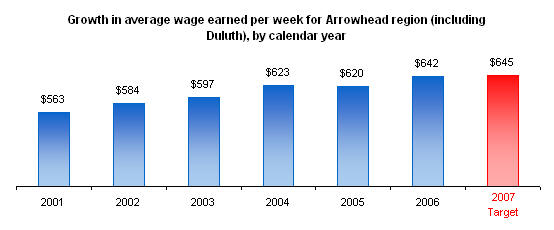|
|||||||||
|
|||||||||
| Goal: Position Iron Range Resources to be a leader in developing and implementing a strategy for the long-term economic viability of northeastern Minnesota | |||||||||
|
Why is this goal important? Iron Range Resources also plays a
leadership role creating a vision for sustainable growth and change within
the region. With ties to communities as well as business and industry, Iron
Range Resources is the primary government convener that engages stakeholders
in situational assessments, issue discussions and strategic thinking.
Building consensus around strategies for the future is the first step in
choosing a course for change.
What is the department’s progress to
date?
New Technology and
Next Generation Resources The project is anticipated to generate over $704 million in revenue over 20 years, with $20 million spent annually in labor, fuel and materials. Up to 70 jobs are expected to be retained, with a possible 100-plus new jobs in the wood yard, transportation and tree growth aspects of the operation. The LEA biomass
energy project, funded in part by Iron Range Resources, preserves
public utilities, creates new jobs, reduces reliance on fossil fuels,
improves environmental impacts,
Other next generation
resource projects are in various
stages of development and
showing strong potential. They include the Mountain Iron Pellet Plant,
Minnesota Power Wind, Excelsior Energy, Coal Gasification, Bois Forte
Cellulosic Ethanol, and the Mountain Iron Community Based Energy Development
(CBED) Wind Power Project.
Biomass Facility at the Department of Public Utilities, Virginia, MN
Giants Ridge® Golf and Ski Resort - In March 2007, Giants Ridge resort stakeholders unveiled a 10-year master plan for the Giants Ridge recreation area, which holds the potential of unprecedented residential and commercial growth for the eastern end of the Mesabi Range. The master plan contemplates investments approaching one billion dollars over the next decade. Annual economic impact to surrounding communities could exceed $50 million by 2010, and upon full build out, annual tax revenues to local governments could exceed $10 million.
The Giants Ridge
Recreation Area is comprised of 10,000 acres of land owned by both public
and private parties. Iron Range Resources owns over 1,600 acres and the
master plan is driven by the agency selling land parcels to private entities
that in turn, generate future development. |
|||||||||
| Goal: Sustain the region’s economic base by supporting existing businesses in their efforts to retain jobs and create new jobs | |||||||||
|
Why is this goal
important?
What is Iron Range Resources doing to achieve this
goal? |
|||||||||
|
What is the department’s progress to date?
Expansion
of Area Companies Grants Assistance Iron Range Resources made 45 discretionary grants to communities, nonprofits, higher education and businesses totaling just under $3.5 million. Grants supported infrastructure that addressed barriers to business growth, research and development for new initiatives, and tourism.
Forest Products and Mining
Iron Range Resources participated in task
forces and action teams to address forest industry issues, including:
The
Governor’s Task Force on the Competitiveness of Minnesota’s Primary Forest Products Industry, Co-chaired by
Commissioner Layman and the Commissioner of the Minnesota Department of
Natural Resources. The agency also established a Forest Industry Assistance Program following difficulties in the national housing industry that impacted area loggers and board mill production. The assistance program was implemented by authorization of a $2 million grant to the Laurentian Energy Authority, who in turn purchased cords of wood from areas loggers to fuel the biomass plants operating in Hibbing and Virginia.
Fifteen mandatory grants of $9.6 million dollars were
made for mining and mine-related paybacks through TEDF funds. Four of five
eligible mining companies have reported an aggregate total of $18.6 million
dedicated to capital reinvestments. Project to agency leverage for this
program is 2:1. |
|||||||||
| Goal: Diversify the region’s economy by supporting the growth of new businesses and recruiting new businesses from outside the area | |||||||||
|
Why is this goal important? Target Recruitment
Workforce Development The WIB has also improved communication between industry and education stakeholders. Additional results of workforce development include high school and post-secondary curriculum planning that has lead to an increase in the number of programs available for students, such as the Applied Learning Initiative and Project Lead the Way. These programs prepare today’s students for tomorrow’s workforce by providing a seamless transition from school to work. Post-secondary schools are also actively meeting industry demands for custom training through coordinated efforts and partnerships.
|
|||||||||
| Goal: Reclaim mining impacted lands to create a diverse regional economic development resource | |||||||||
|
Why is this goal important? The agency also plays a role incorporating reclamation objectives into the active mining process through a Laurentian Vision Partnership (LVP). The LVP was formed to address post-mining land design as an integral part of day-to-day mining operations. It involves the region’s stakeholders and beneficiaries in the planning process to consider the economic, recreational and environmental impact of current activities on future projects. How will Iron Range
Resources achieve this goal? What is
the department's progress to date?
A total of 150,000 seedlings were planted and used to re-forest 150 acres of land at United Taconite, Keewatin Taconite, Hibbing Taconite, Minntac, Northshore Mining, and St. Louis County, Ely.
|
|||||||||
|



 capital and other financial
incentives for 36 business expansions since FY2004, for a total of $18.2
million in assistance. These projects leveraged $97.2 million dollars and
resulted in 2,059 jobs retained and 644 projected new jobs.
capital and other financial
incentives for 36 business expansions since FY2004, for a total of $18.2
million in assistance. These projects leveraged $97.2 million dollars and
resulted in 2,059 jobs retained and 644 projected new jobs.